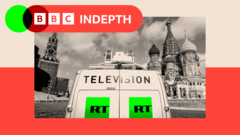In a move that highlights Russia's ambition to expand its influence, state-backed media have been making inroads in regions traditionally underserved by Western news outlets. As US, UK, Canadian, and EU sanctions and restrictions limit the reach of channels like RT in those regions, the Russian broadcaster has found fertile ground elsewhere, particularly in Africa and Latin America.
One such viewer, Javier Gallardo from Chile, experienced this shift firsthand when a local television channel began airing RT content without prior notice. His bewilderment reflects a broader confusion among audiences in regions where Russian state media have adopted a more dominant position.
RT, along with Sputnik, has made significant strides over the past three years, extending its reach to Africa, the Balkans, the Middle East, and Southeast Asia, particularly following its ban in much of the West after Russia invaded Ukraine in 2022. Meanwhile, the network has opened new bureaus and established training programs for journalists around the world, indicating a commitment to influence perceptions in these markets.
Experts suggest that Russia’s narrative resonates more in these regions due to historic anti-colonial and anti-imperialist sentiments. While it is viewed in the West as a vehicle for disinformation, many in Africa and Latin America see RT as a legitimate source, fostering a complex relationship with global media narratives.
A significant expansion of Russian media is particularly visible in Africa, where media initiatives cater to local audiences. For instance, RT has tailored its content to engage French-speaking African nations, aiming to increase its foothold and counteract Western narratives. The narrative posited by Russian media shifts with the audience, presenting a more favorable view of its actions across different regions.
Importantly, the increase in Russian media presence coincides with the retreat of some Western media outlets from these regions, leading to a vacuum that RT and Sputnik are keen to fill. While studies indicate that audiences may recognize some bias in these channels, the degree of understanding regarding their manipulation of facts varies, highlighting a potential risk for misinformation.
Furthermore, RT's foray into broadcasting and training journalists in Africa poses questions about its impact on public opinion and prevailing narratives around issues like the conflict in Ukraine. Through strategic messaging, Russia portrays itself as a defender of the Global South against Western aggressions, hoping to solidify its geopolitical influence.
In Latin America, RT is available for free-to-air broadcasts in multiple countries, further establishing its role as a counter-narrative to traditional Western media. While quantifying the actual audience engagement of Russian state media remains challenging, assertions of their viewership numbers indicate a willingness to present inflated metrics.
As Russia continues to expand its media reach, experts warn of the broader implications for democracy and the global order. With the West facing criticisms regarding a reduction in media funding and presence in key regions, the Russian strategy capitalizes on these gaps to assert its narrative worldwide.
In conclusion, while RT and Sputnik’s increasing prominence raises alarms over misinformation and geopolitical manipulation, the complexity of media perception and audience engagement in diverse regions complicates the narrative, warranting a closer examination of global media dynamics in the contemporary era.


















